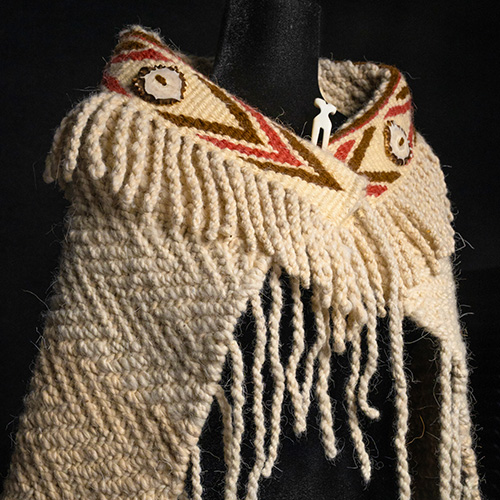As a high school student in China who excelled at physics, Jueqian Fang was expected to pursue a science degree in college. “I was good at science, and if you’re good at it you’re supposed to do it,” she recalls. But Fang wasn’t convinced she was on the right path. She decided to attend the UW, welcoming the opportunity to explore other options.
Fast forward four years, and Fang is graduating with a double major in photomedia in the School of Art + Art History + Design, and cinema studies in the Department of Comparative Literature. She is also the 2014 Dean’s Medalist in the Arts, selected on the basis of academic performance and faculty recommendations.

“Jueqian epitomizes everything we could ask for in a student artist,” says Rebecca Cummins, associate professor of art in the Photomedia Program. “Extraordinary commitment, tenacity, intelligence, skill, talent, generosity, and resolve.”
Fang was interested in the Photomedia Program from the start, appreciating the openness of the program. She explains that she is drawn to visual art “because there are things that I don’t know how to explain—ambiguous incidents that affect me, and peculiar situations that stick out in my mind for inexplicable reasons. My works are often about the framing of those situations. They do not make sense but exist as they are, very humble and mundane. I attempt to accentuate these things because they cannot be explained. They may only be perceived, in different ways.”
Reflecting photomedia’s reach beyond traditional photography, Fang’s portfolio includes photographs, short videos, performance pieces, and installations that eschew the expected. “Her work always surprises, raising the level of conceptual and visual rigor in every class she has taken,” says Ellen Garvens, professor of art and chair of the Photomedia Program. “She sees and understands on several levels at once, quickly conceptualizing what is depicted with what is implied, and how it resonates beyond the art object.”
Jueqian epitomizes everything we could ask for in a student artist. Extraordinary commitment, tenacity, intelligence,skill, talent, generosity, and resolve.
Fang has been included in several exhibits on campus, as well as a national juried show at a gallery in Seattle’s Pioneer Square alongside established professional artists. She also has done “interventions,” or guerilla-style projects, at museums across the country. To see the latter, you’d have to be in the right place at the right time—the right place being the ladies room at whatever museum Fang happened to visit that day.
The interventions were inspired by a friend who used cake icing to do temporary graffiti. Fang covered museum toilet seats with artfully arranged fruit and frosting, as if topping a cake. “It was just for fun,” she explains. “I’d set them up, take photos, and then walk away.” Her work has graced the restrooms at the Seattle Art Museum, the Henry Art Gallery, the San Francisco Museum of Modern Art, the Museum of Fine Arts in Boston, and more. She only returned to check on an installation once, at New York’s Museum of Modern Art. “An hour later, it was all gone,” she says.

As her far-flung museum visits suggest, Fang is an inveterate traveler. In addition to trips across the US, she has participated in three study abroad programs. First was a summer program in China through the Cinema Studies Program, then came SEA Semester—a Woods Hole sailing program that combined oceanography, humanities, and nautical science. More recently Fang studied in Spain through a School of Art program.
When she’s not traveling, she can nearly always be found in the Art Building. “I basically live in the photomedia studio in the basement of the building,” she says, only half joking. “I’m there 24/7.” She also has carved out time to intern for introductory and intermediate photography courses. “She has the rare ability to elegantly offer direct criticism, valuable suggestions, and encouragement in a supportive yet challenging manner,” says Cummins. “She adds a very positive twist to the learning environments in which she participates.”

Fang hopes to pursue art in Seattle for a while longer before returning to China. “The art community is relatively small and separate anywhere in the world, because a lot of people don’t ‘get’ contemporary art,” she says. “But in China, that community is even more separate.”
Wherever she finds herself, one thing is certain: Fang might have excelled at physics in high school, but at the UW she discovered her true passion as an artist.
To view more of Jueqian Fang's work, including photographs, videos, and short performance pieces, visit www.fangjueqian.com.
More Stories

A Healing Heart Returns
In February, the UW Symphony will perform a symphony that Coast Salish elder Vi Hilbert commissioned years ago to heal the world after the heartbreak of 9/11. The symphony was first performed by the Seattle Symphony in 2006.

The Public Impact of Private Cities
Geography major Edwin Bai has researched private cities, developed by individuals and corporations, that "take the libertarian idea of low government regulation to the maximum."

Coast Salish Traditions are "Woven in Wool" at the Burke
A Burke Museum exhibit, co-curated by Coast Salish weavers and Burke curators, highlights the importance of weaving to Coast Salish communities.